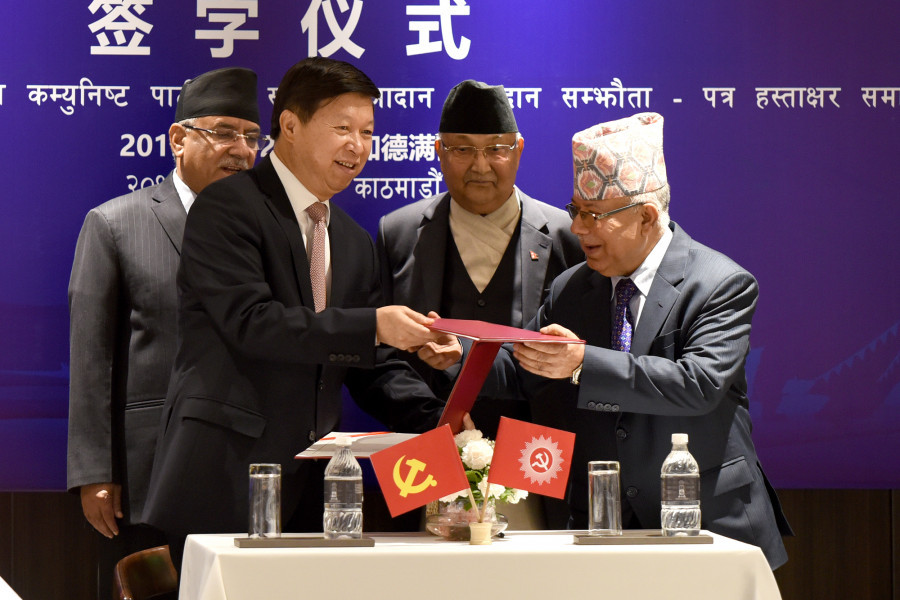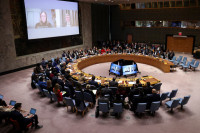Columns
Why Indo-US policies failed in Nepal
The two powers have often bet on the wrong side, attempting to fulfil short term interests over promoting democracy.
Achyut Wagle
Nepal received exceptionally unusual attention in the Indian and, to some extent, Western media last week when a Chinese delegation headed by Vice Minister of the International Department of the Communist Party of China Guo Yezhou rushed to Kathmandu. The four-member delegation was here 'to avert' an impending vertical split in the ruling Nepal Communist Party. An extreme extra-constitutional move to dissolve the House of Representatives by Prime Minister KP Oli on December 20 was the climax of the intra-party feud that had intensified in recent months.
The general prognosis of these news reports and op-ed pieces was that the Chinese influence in Nepal is growing and the Communist Party of China was working hard to prevent the break-up of its 'brotherly' Nepali counterpart. The CPC, and Guo in particular, was credited for purported success in unifying two communist forces. The two parties had first formed an electoral alliance three and a half years ago and merged into one in May 2018.
There is a sort of incessant battle between Indian and Chinese media over what happens in Nepali politics, including the current episode. When Hindustan Times published an op-ed claiming that the split in the NCP 'hurts China' and accused China of interfering in Nepal's domestic affairs, the Chinese official mouthpiece, the Global Times, countered it as an Indian 'tactic to drive a wedge between China and Southeast Asian countries'. The paper declared, 'The coordinative role played by China should not be viewed as interference in Nepal's internal politics. The accusations from the Indian side are groundless'. Nepal very often than not finds itself at the middle of this battle for regional influence between its two powerful neighbours; its top political leaders have often fallen prey to machinations from both sides.
There is no hiding of the fact that Chinese interest and engagement in Nepali politics has exponentially grown in recent years. Also, it has irked India, which fears losing its 'traditional' sphere of influence. For countries like the United States, the expansion of the Chinese model of socialism seems to be the main cause for concern. But the fact of the matter is: the growing influence and engagement of the CPC with the NCP is an obvious outcome of the gradual rise—and now an enveloping dominance—of communist politics in Nepal. It is coupled with a substantive change in Chinese policy from absolute non-interference in the past to an active interest in Nepal's political developments.
Strategic interest first
For a moment, let's put aside Nepal's own worry of political instability and its fallouts. If China's increased interest in Nepali politics is a cause of concern for India, and also the US for that matter, to reiterate, both of them must accept the fact that it is primarily due to the dominance of communist forces that has overshadowed democratic politics in the country. Ironically though, the rapid rise of the communists to power is largely due to the comprehensive failure of Indian and US foreign policies in Nepal.
The US policy failure came in two ways: one, an aberration from their purported principles of promoting democracy and inconsistencies in choosing partners for political engagement, and two, fleeting approaches in policy pursuit. The promotion of democracy in Nepal has come second to its strategic interest. It began in the 1950s at the height of the Cold War when China became a communist state. The US had a significant strategic interest in the region thus chose to use and treat Nepal as an outpost and portal to China.
The most significant policy distortion was the US’s support of king Mahendra after he sacked the elected government in a coup d'état in 1960. Hoping that Mahendra would be a natural adversary to communist China, it chose the wrong bedfellow by complementing the coup as accomplished 'with great secrecy and superb organisation'. After 1960, the US slowly shifted its approach in Nepal, embracing the monarchy and moving away from democratic reform. In later years, the US chose to view Nepal through Indian lenses and took the strategy of not antagonising India at the cost of supporting Nepal. It was paradoxically evident when Nepal was ravaged by the Maoist insurgency with tacit Indian support to it, as highlighted in the book R&AW & Civil Intelligence a Factful Analysis by CP Thakur, the US was seen completely reluctant to provide political support to the democratic establishment here. So much so, the US has even now failed to convince the ruling communist stalwarts to accept aid worth $500 million under the Millennium Challenge Corporation Compact.
Disrespect to democracy
As for India, its recipe of economic blockades has been enough to give rise to the ultra-nationalist communist demagogy that catapulted communist leaders like KP Oli and Pushpa Kamal Dahal into power. In recent history, India imposed three crippling economic blockades—in 1970, 1989 and 2015. Incidentally, all these blockades actually were linked to Nepal's relations with China. The 1970 blockade was against the construction of the Kathmandu-Kodari Highway that connected Nepal with China by road. The second in 1989 was to protest Nepal's purchase of Chinese arms. And the third was to express India's displeasure with Nepal's promulgation of a new federal constitution 'without consulting India and at the behest of China'.
Much like the US, India has undermined Nepal's democratic forces and processes. It has embraced hardliner communists like Dahal even to the utter surprise of China. In a bid to support pro-Indian parties in the Tarai, it substantially weakened democratic allies like Nepali Congress. By failing to recognise Nepal's new constitution that was democratically voted in by 90 percent of the popularly elected Constituent Assembly members, and then imposing a six-month-long constricting blockade, India massively fueled the anti-Indian sentiments in an entire generation of young voters. This was capitalised by Oli-Dahal brand of communist-nationalistic rhetoric and forced Oli to posture as if leaning towards China.
Even now, if India is basking on the feigned success of winning back Oli and breaking the NCP, it would be another wrong policy bet. This in no way is going to help consolidate Nepal's democracy, without which communist influence in the country's politics is unlikely to recede. China, on the other hand, is rather fast in changing its policy tack. When it realised Oli cannot be a dependable ally in the long run, last week's visiting Chinese delegation also called on Nepali Congress President Sher Bahadur Deuba in an effort to convey the message that CPC would like to revert to its 'equidistance' policy towards all major political parties of Nepal. Perhaps other powers can take note.




 6°C Kathmandu
6°C Kathmandu















